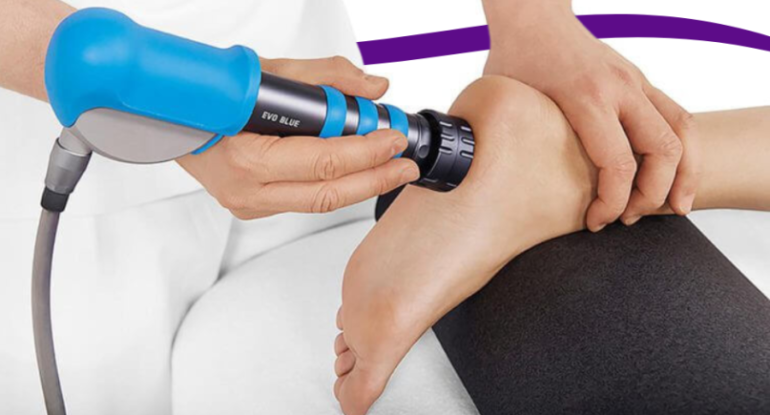13588 88 Ave #202, Surrey, BC V3W 2P5
Welcome to King George Physio!
-
Call for help: (604) 503-5682
-
Welcome to King George Physio!
Call for help: (604) 503-5682

Plantar fasciitis is one of the most common causes of heel pain, affecting millions of people worldwide. The condition occurs when the thick band of tissue (the plantar fascia) that supports the arch of your foot becomes inflamed or irritated. While conservative treatments like rest, stretching, and orthotics can help, persistent cases often require advanced therapies. One of the most effective modern treatments is Shock Wave Therapy (SWT), a non-invasive procedure that helps reduce pain and accelerates healing.
In this blog, we’ll explain what shock wave therapy is, how it works for plantar fasciitis, its benefits, recovery timeline, and what patients can expect.
Shock wave therapy, also called Extracorporeal Shock Wave Therapy (ESWT), uses high-energy sound waves to target injured tissues. These waves stimulate blood circulation, promote cell regeneration, and trigger the body’s natural healing response. Originally used in urology to break kidney stones, shock wave therapy has become widely recognized in orthopedics and sports medicine for treating chronic pain conditions like plantar fasciitis, tennis elbow, and Achilles tendinopathy.
Plantar fasciitis pain is caused by micro-tears and inflammation in the plantar fascia ligament. Traditional treatments often provide temporary relief, but shock wave therapy addresses the root cause. Here’s how it works:
Read More Blogs: What Is Shock Wave Therapy in Physiotherapy?
Long-Lasting Relief: Many patients experience permanent pain reduction after a full treatment course.
1. Initial Consultation
Your doctor will assess your heel pain, medical history, and previous treatments before recommending SWT.
2. Procedure
A gel is applied to the heel.
A handheld device delivers targeted shock waves to the plantar fascia.
The session takes 15–20 minutes and usually requires 3–5 treatments spaced over several weeks.
3. Pain Level
Some patients feel mild discomfort during the procedure, but it is generally well tolerated.
Long-Term: Most patients enjoy long-lasting results, especially when combined with stretching, supportive footwear, and lifestyle changes.
You may be a candidate for SWT if:
Shock wave therapy is considered safe, but some patients may experience:
– Redness or swelling
– Mild bruising
– Temporary pain increase
These side effects are usually mild and resolve within a few days.
Studies show that 70–80% of patients with chronic plantar fasciitis experience significant pain relief after shock wave therapy. It’s especially beneficial for athletes, runners, and individuals whose jobs require prolonged standing. The success rate is higher when combined with stretching, strengthening, and proper footwear.
Avoid High-Impact Activities: Limit running and jumping until cleared by your doctor.
Plantar fasciitis can be a frustrating and painful condition, but shock wave therapy offers a safe, effective, and non-invasive solution for long-term relief. By stimulating natural healing, improving blood flow, and reducing pain signals, SWT helps patients recover faster and return to normal activities without surgery.
If you’ve been struggling with heel pain that hasn’t improved with traditional treatments, talk to your professional physiotherapist about whether shock wave therapy could be the right option for you.
Most patients require 3–5 sessions spaced over several weeks. The exact number depends on the severity of the condition and how well the body responds to treatment.
Some patients feel mild discomfort during the procedure, but it is usually well tolerated. Any soreness afterward is temporary and typically resolves within a few days.
Patients often notice improvement within 2–4 weeks, with maximum relief achieved after 6–12 weeks.
Yes, it is considered safe and non-invasive. Mild side effects like redness or swelling may occur but usually subside quickly.
Relapse is uncommon, especially if patients follow post-treatment care such as stretching, wearing supportive shoes, and avoiding high-impact activities.
Most patients require 3–5 sessions spaced over several weeks. The exact number depends on the severity of the condition and how well the body responds to treatment.
Some patients feel mild discomfort during the procedure, but it is usually well tolerated. Any soreness afterward is temporary and typically resolves within a few days.
Patients often notice improvement within 2–4 weeks, with maximum relief achieved after 6–12 weeks.
Yes, it is considered safe and non-invasive. Mild side effects like redness or swelling may occur but usually subside quickly.
Relapse is uncommon, especially if patients follow post-treatment care such as stretching, wearing supportive shoes, and avoiding high-impact activities.